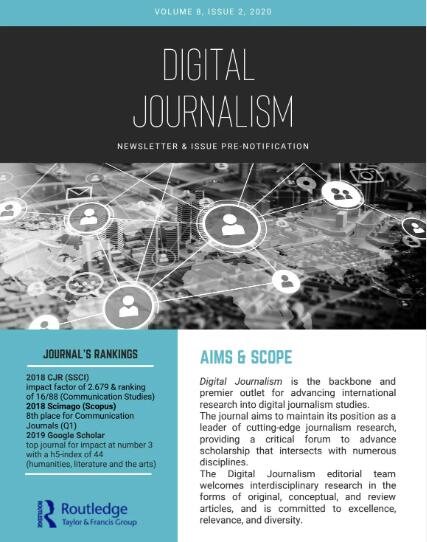照片、视觉表情包和病毒视频:在西班牙、意大利和荷兰的COVID-19大流行期间,WhatsApp上的视觉新闻分享
IF 5.4
1区 文学
Q1 COMMUNICATION
引用次数: 0
摘要
在WhatsApp群中分享和讨论视觉图像是一种幽默的新闻分享形式,可以达到一种团聚感和社交感。我们探讨了在COVID-19大流行的头几个月严格封锁期间,在个人WhatsApp互动中共享的视觉媒体内容是如何成为热门新闻的。我们的研究填补了新闻学研究在从用户角度研究新闻相关内容和视觉内容方面的空白。我们的文章深入探讨了WhatsApp的“半私密”空间如何为人们提供一个数字通信空间,以应对在危机期间成为新闻主题的问题:人们通过将新闻塑造成不同的视觉形式来适当地利用新闻,这些形式可以在WhatsApp上吸引人地分享。我们专注于西班牙,意大利和荷兰城市地区的工作成年人(25-49岁)。WhatsApp上的视觉新闻分享结合了公共和私人方面,特别是人们如何通过他们的私人WhatsApp通信来解决公众关注的问题。我们的结论揭示了WhatsApp在处理可怕和令人不安的危机情况时,是如何作为一种意义建构实践和本体安全工具发挥作用的。分享的视觉图像是一种混合形式的交流,模糊了私人生活和新闻中呈现的公共关注点之间的界限。本文章由计算机程序翻译,如有差异,请以英文原文为准。
Photographs, Visual Memes, and Viral Videos: Visual Phatic News Sharing on WhatsApp during the COVID-19 Pandemic in Spain, Italy, and The Netherlands
Sharing and discussing visual images in WhatsApp groups functions as a form of phatic news sharing to achieve a sense of togetherness and sociability. We explore how visual media content shared in personal WhatsApp interactions during the first strict lockdown months of the COVID-19 pandemic functions as phatic news. Our study addresses a gap in journalism studies in researching news-related and visual content from user perspectives. Our article provides insights into how the “semi-private” space of WhatsApp offers people a digital communication space to deal with becoming a news subject during the crisis: people appropriate news by shaping it into different visual forms which can be attractively shared on WhatsApp. We focus on working adults (aged 25–49) in urban areas in Spain, Italy, and the Netherlands. Visual phatic news sharing on WhatsApp combines public and private aspects, especially how people address issues of public concern through their private WhatsApp communication. Our conclusions reveal how WhatsApp functions as a sense-making practice and vehicle for ontological security in dealing with the fearful and unsettling crisis situation. The visual images shared are a hybrid form of communication, blurring boundaries between private life and public concerns presented on the news.
求助全文
通过发布文献求助,成功后即可免费获取论文全文。
去求助
来源期刊

Digital Journalism
COMMUNICATION-
CiteScore
11.20
自引率
24.10%
发文量
103
期刊介绍:
Digital Journalism provides a critical forum for scholarly discussion, analysis and responses to the wide ranging implications of digital technologies, along with economic, political and cultural developments, for the practice and study of journalism. Radical shifts in journalism are changing every aspect of the production, content and reception of news; and at a dramatic pace which has transformed ‘new media’ into ‘legacy media’ in barely a decade. These crucial changes challenge traditional assumptions in journalism practice, scholarship and education, make definitional boundaries fluid and require reassessment of even the most fundamental questions such as "What is journalism?" and "Who is a journalist?" Digital Journalism pursues a significant and exciting editorial agenda including: Digital media and the future of journalism; Social media as sources and drivers of news; The changing ‘places’ and ‘spaces’ of news production and consumption in the context of digital media; News on the move and mobile telephony; The personalisation of news; Business models for funding digital journalism in the digital economy; Developments in data journalism and data visualisation; New research methods to analyse and explore digital journalism; Hyperlocalism and new understandings of community journalism; Changing relationships between journalists, sources and audiences; Citizen and participatory journalism; Machine written news and the automation of journalism; The history and evolution of online journalism; Changing journalism ethics in a digital setting; New challenges and directions for journalism education and training; Digital journalism, protest and democracy; Journalists’ changing role perceptions; Wikileaks and novel forms of investigative journalism.
 求助内容:
求助内容: 应助结果提醒方式:
应助结果提醒方式:


